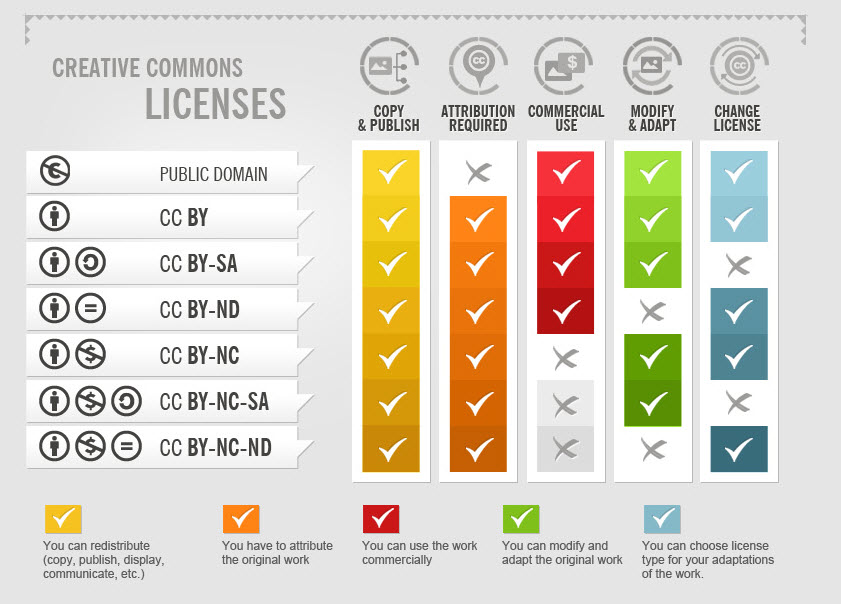Creative Commons Licensing for OER
Creative Commons (CC) licenses are the foundation of OER. CC licenses allow creators to directly state how they would like others to use their work. Every CC license requires that the user give attribution to the creator if they use the material.
Creative Commons licenses have four components:
- Attribution (BY): Proper attribution must be given to the original creator of the work whenever a portion of their work is reused or adapted. This includes a link to the original work, information about the author, and information about the original work’s license.
- Share-Alike (SA): Iterations of the original work must be made available under the same license terms.
- Non-Commercial (NC): The work cannot be sold at a profit or used for commercial means such as for-profit advertising. Copies of the work can be purchased in print and given away or sold at cost.
- No Derivatives (ND): The work cannot be altered or “remixed.” Only identical copies of the work can be redistributed without additional permission from the creator.
These components can be combined to generate a license that aligns with how you’d like others to use your work. The most permissive is CC-BY (do anything with my work but you must attribute me) and the least permissive is CC-BY NC ND (no derivatives, no commercial use, you must attribute me). There is also a CC0 (CC Zero) license that dedicates the work to the worldwide public domain. A full description of all the license types is available on the Creative Commons website.
Three of the Creative Commons Licenses (CC-BY, CC-BY-SA, and CC-BY-ND ) allow others to use your work for commercial purposes. For example, Lumen Learning partners with OpenStax and blends content with other OER material and supplements this with its homework management system and ancillary videos, PowerPoint slides, and online assessments. Lumen then sells access via a “low-cost support fee” to institutions. Inside Higher Ed reports that Macmillan Learning, Cengage, Pearson, and McGraw-Hill have all introduced products that incorporate OER into commercial proprietary platforms.
If you do not want your work to be used in this way, select a license that includes NC, the Non-Commercial component. These are CC-BY-NC, CC-BY-NC-SA, CC-BY-NC-ND.
This graphic from Fotor shows how the components of a CC license interact with each other. The graphic notes that all licenses except CC0 (public domain) have a “BY” component, which requires those users to attribute the original creator. The image then breaks down each license by whether it allows commercial use, modification, and if the user can select a different license once they make modifications. The graphic illustrates that CC 0 and CC BY are the least restrictive license, while CC BY NC SA and CC BY NC ND are the most restrictive licenses.
For a walkthrough of CC licenses, see the video below by Process Arts from New Zealand (~5.5 minutes) Note that this video was created before the addition of CC0.
Other Helpful Resources
- CC Licenses Explained in Plain English, Sara F. Hawkins
- To help you determine which CC license is right for you, try the License Chooser tool on the Creative Commons website.
ascribing of a work (as of literature or art) to a particular author or artist (i.e. give credit)



